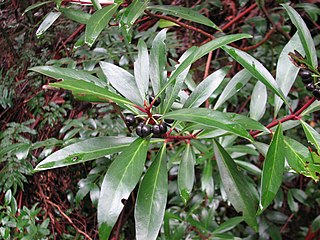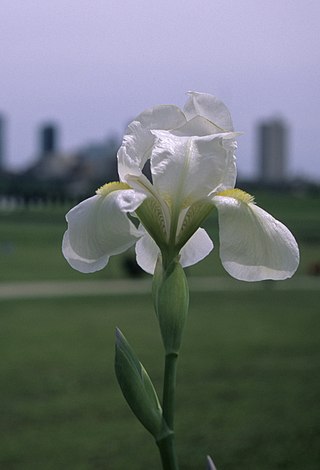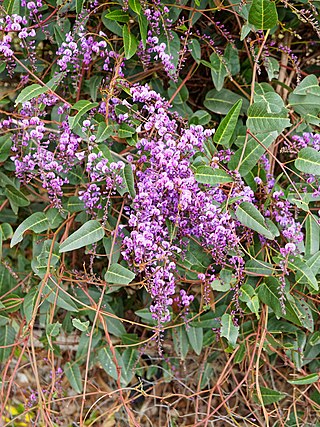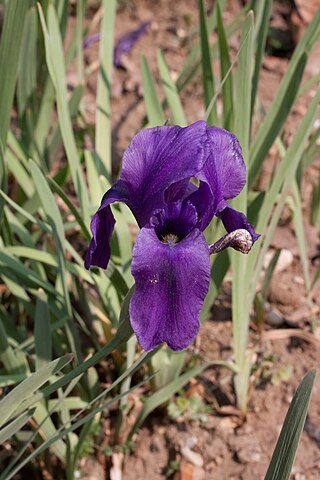
A cherry is the fruit of many plants of the genus Prunus, and is a fleshy drupe.

Iris is a flowering plant genus of 310 accepted species with showy flowers. As well as being the scientific name, iris is also widely used as a common name for all Iris species, as well as some belonging to other closely related genera. A common name for some species is flags, while the plants of the subgenus Scorpiris are widely known as junos, particularly in horticulture. It is a popular garden flower.

Leptospermum scoparium, commonly called mānuka, mānuka myrtle, New Zealand teatree, broom tea-tree, or just tea tree, is a species of flowering plant in the myrtle family Myrtaceae, native to New Zealand and south-east Australia. Its nectar produces Mānuka honey.

Eucryphia is a small genus of trees and large shrubs native to the south temperate regions of South America and coastal eastern Australia, mainly Tasmania. Sometimes placed in a family of their own, the Eucryphiaceae, more recent classifications place them in the Cunoniaceae. There are seven species, two in South America and five in Australia, and several named hybrids.

Crocosmia (;), also known as montbretia, is a small genus of flowering plants in the iris family, Iridaceae. It is native to the grasslands of southern and eastern Africa, ranging from South Africa to Sudan. One species is endemic to Madagascar.

Dietes is a genus of rhizomatous plants of the family Iridaceae, first described as a genus in 1866. Common names include wood iris, fortnight lily, African iris, Japanese iris and butterfly iris, each of which may be used differently in different regions for one or more of the six species within the genus.

Iris pseudacorus, the yellow flag, yellow iris, or water flag, is a species of flowering plant in the family Iridaceae. It is native to Europe, western Asia and northwest Africa. Its specific epithet pseudacorus means "false acorus", referring to the similarity of its leaves to those of Acorus calamus, as they have a prominently veined mid-rib and sword-like shape. However, the two plants are not closely related. The flower is commonly attributed with the fleur-de-lis.

Diplarrena is a genus of flowering plants in the family Iridaceae. The two species are endemic to Australia. The name is from Greek diploos ("double") and arren ("male"); plants in the genus have only two functional stamens, while all other Iridaceae have three. The name is often misspelled Diplarrhena, an error that began with George Bentham's Flora Australiensis in 1873.

Tasmannia lanceolata, commonly known as Tasmanian pepperberry or mountain pepper, is a shrub native to woodlands and cool temperate rainforest of south-eastern Australia. The shrub varies from 2 to 10 m high. The aromatic leaves are lanceolate to narrow-elliptic or oblanceolate, 4–12 cm long, and 0.7–2.0 cm wide, with a distinctly pale undersurface. Stems are quite red in colour. The small cream or white flowers appear in summer and are followed by black, globose, two-lobed berries 5–8 mm wide, which appear in autumn. There are separate male and female plants.

Iris sibirica, is a species in the genus Iris. It is a rhizomatous herbaceous perennial, from Europe and Central Asia. It has long green grass-like leaves, tall stem, 2–5 violet-blue, to blue, and occasionally white flowers. It is cultivated as an ornamental plant in temperate regions.

Hymenosporum is a monotypic genus in the family Pittosporaceae. The sole included species is Hymenosporum flavum, commonly known as native frangipani, which is a rainforest tree native to New Guinea, Queensland and New South Wales. Despite its common name, it is not closely related to the frangipani, but is related to the widespread genus Pittosporum.

Iris albicans, also known as the cemetery iris, white cemetery iris, or the white flag iris, is a species of iris which was planted on graves in Muslim regions and grows in many countries throughout the Middle East and northern Africa. It was later introduced to Spain, and then other European countries. It is a natural hybrid.

Hardenbergia violacea is a species of flowering plant in the family Fabaceae and is endemic to Australia. It is known in Australia by the common names false sarsaparilla, purple coral pea, and waraburra. Elsewhere it is also called purple twining-pea, vine-lilac, and wild sarsaparilla. It is a prostrate or climbing subshrub with egg-shaped to narrow lance-shaped leaves and racemes of mostly purple flowers.

Iris × germanica is the accepted name for a species of flowering plants in the family Iridaceae commonly known as the bearded iris or the German bearded iris. It is one of a group of hybrid origin. Varieties include I. × g. var. florentina.

Moraea bituminosa is a species of the genus Moraea in family Iridaceae.

Escallonia bifida, the cloven gum box, is an evergreen shrub or small tree in the family Escalloniaceae. It is native to Brazil and Uruguay.

Iris winogradowii is a species of flowering plant in the genus Iris, classified in the subgenus Hermodactyloides and section Reticulatae. It is a bulbous perennial, from the Caucasus mountains of Azerbaijan and Georgia.

Iris hookeri, commonly called the beach head iris, is a species of Iris. It is endemic to sea coasts and beaches in Maine, in the Northeastern United States and also eastern Canada.

Iris ruthenica, sometimes called ever blooming iris, Russian iris, pilgrim iris and Hungarian iris, is a species in the genus Iris- subgenus Limniris. It is a rhizomatous perennial, with a wide distribution, ranging from eastern Europe to Central Asia. It has grass-like leaves, thick stem and violet or bluish lavender flowers which are marked with violet veining.

Iris hoogiana is a plant species in the genus Iris, it is also in the subgenus Iris and in the section Regelia. It is a rhizomatous perennial, from the grassy mountainsides of Turkestan. It has long green leaves, which are slightly purple at the base, and a long slender flowering stem. The flowers are blue, ranging from sky-blue to lavender blue and blue purple. It has orange or yellow beards. It is cultivated as an ornamental plant in temperate regions.




















